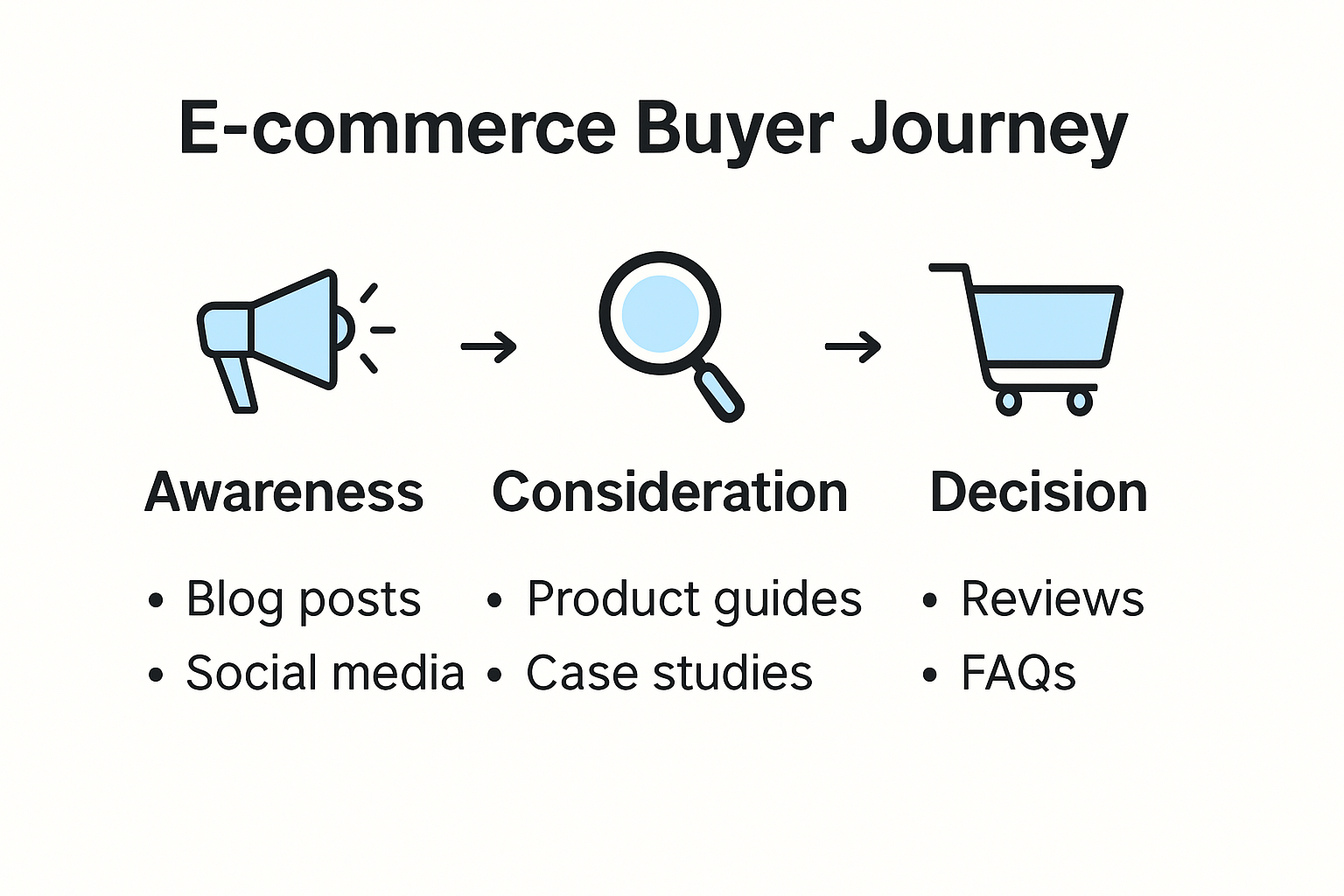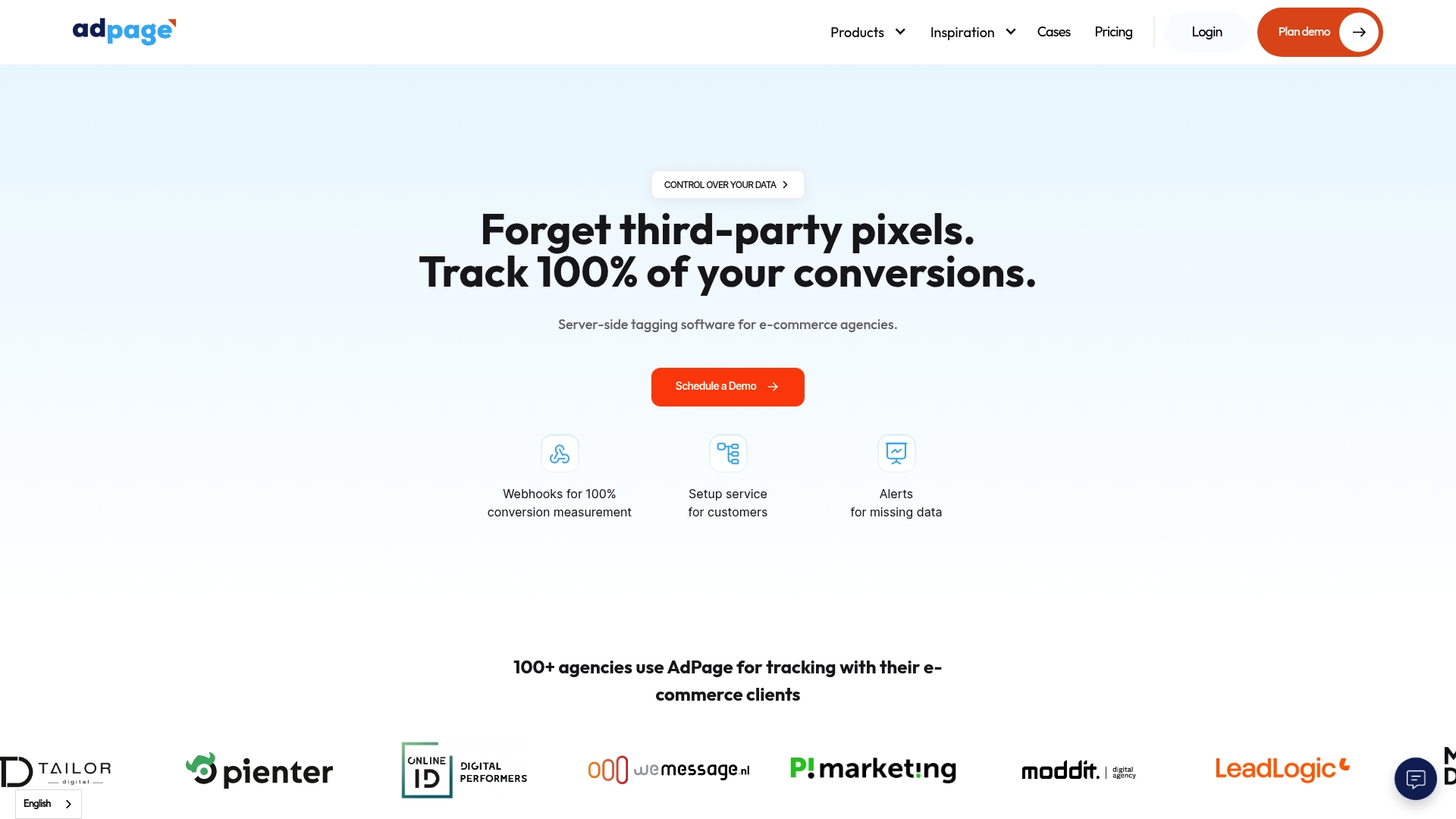E-commerce content marketing is evolving at a pace nobody saw coming and brands are scrambling to keep up. Video might be the darling of engagement right now and some might say just stick to what works. Yet blogs can actually drive up to 67% more leads per month for companies and a smart use of AI can elevator conversion rates by over 8%. This means that what feels traditional or technical could become your most unexpected engine for growth in 2025.
Table of Contents
- Understanding E-Commerce Buyer Journeys
- Proven Content Types That Drive Sales
- Leveraging Analytics For Content Optimization
- Integrating Content With Conversion Strategies
Quick Summary
| Takeaway | Explanation |
|---|---|
| Understand buyer journeys deeply | Recognize the importance of multiple digital touchpoints in guiding consumers toward purchase decisions. |
| Leverage video for engagement | Short-form videos can significantly enhance brand interaction and communicate product benefits effectively. |
| Utilize AI for content optimization | Artificial intelligence can create hyper-personalized marketing content, increasing engagement and conversion rates. |
| Implement advanced recommendation systems | Dynamic recommendations tailor content to user preferences, improving engagement and driving conversions. |
| Integrate content with conversion strategies | Blending engaging narratives with data-driven tactics transforms content into powerful tools for generating sales. |
Understanding E-Commerce Buyer Journeys
E-commerce buyer journeys represent a complex series of interactions and decision-making processes that transform potential customers from initial awareness to final purchase. Understanding these intricate pathways is fundamental for developing effective content marketing strategies that resonate with consumers and drive conversions.

The Digital Consumer Decision Process
Modern e-commerce consumers navigate a multifaceted journey that extends far beyond traditional linear purchasing models. Research published in the Journal of Theoretical and Applied Electronic Commerce Research reveals that successful marketing strategies must integrate multiple digital touchpoints, considering cultural values and user experience design.
The contemporary buyer journey typically encompasses several critical stages: awareness, consideration, evaluation, purchase, and post-purchase engagement. Each stage demands tailored content that addresses specific consumer needs and psychological motivations. Businesses must craft narratives that not only inform but also build trust and emotional connection.
Below, a table summarizes the stages of the modern e-commerce consumer decision process and the key content focus for each stage:
| Internship | Objective | Content Focus |
|---|---|---|
| Awareness | Capture attention; introduce brand/product | Educational blogs, short-form videos |
| Consideration | Inform, nurture interest, build trust | Product comparisons, how-to guides, testimonials |
| Evaluation | Address objections, provide detailed information | In-depth reviews, FAQs, personalized offers |
| Purchase | Encourage action, remove friction | Clear calls to action, discounts, simple checkout |
| Post-purchase Engagement | Foster loyalty, encourage repeat business | Follow-up emails, user guides, loyalty programs |
Personalization and Content Mapping
Advanced data analytics and machine learning are transforming how businesses understand and predict consumer behaviors. A groundbreaking study exploring LLM-driven marketing content optimization demonstrates that intelligent content strategies can increase click-through rates by 12.5% and conversion rates by 8.3%.
Personalization becomes paramount in this context. By leveraging customer data, businesses can create hyper-targeted content experiences that feel intuitive and relevant. This approach goes beyond demographic segmentation, diving into individual customer preferences, historical interactions, and latent shopping goals.
Technological Innovations in Buyer Journey Mapping.
Cutting-edge research in customer representation and content ranking is revolutionizing how e-commerce platforms understand consumer behavior. The proposed deep learning-based algorithms can improve content personalization metrics by over 12%, enabling more precise and engaging user experiences.
Successful content marketing strategies now require a holistic approach that combines technological sophistication with genuine human understanding. Marketers must balance data-driven insights with creative storytelling, ensuring that each piece of content serves a specific purpose in guiding the consumer through their unique purchasing journey.
By embracing these advanced methodologies, e-commerce businesses can create more meaningful, responsive, and ultimately successful marketing strategies that genuinely connect with their target audiences.
Proven Content Types That Drive Sales

Content marketing for e-commerce demands strategic diversity and precise execution. Different content types serve unique purposes in the customer journey, each designed to capture attention, build trust, and ultimately drive sales.
The following table compares the main content types that drive e-commerce sales, their benefits, and relevant statistics as highlighted in the article:
| Content Type | Key Benefits | Notable Statistic |
|---|---|---|
| Video (Short-form) | High engagement, shareability, quick product showcase | Boosts interaction and brand affinity |
| Blog | SEO, education, trust-building, lead generation | Up to 67% more leads per month |
| AI-Optimized Content | Hyper-personalization, increased conversions | Increases CTR by 12.5% and conversions by 8.3% |
Video Content: The Engagement Powerhouse
Research from the Retail Executive platform highlights short-form video content as a game-changing medium for e-commerce marketing. Platforms like TikTok have revolutionized how brands communicate, demonstrating that concise, engaging videos can significantly boost consumer interaction.
Short-form videos offer multiple advantages: they are easily consumable, shareable, and can quickly communicate product benefits. Brands that master this format can create viral content that not only entertains but also educates potential customers. For instance, brands like Duolingo have successfully used humorous, bite-sized videos to build substantial brand affinity and engagement.
Blog Content: The SEO and Education Catalyst
Studies from Smart Insights reveal that companies maintaining well-curated blogs generate up to 67% more leads per month. Blogs are not merely content repositories but powerful tools for organic traffic generation and customer education.
Effective blog content goes beyond product descriptions. It addresses customer pain points, provides in-depth product insights, offers how-to guides, and establishes brand authority. By strategically incorporating targeted keywords and delivering valuable information, blogs can significantly improve search engine rankings and customer trust.
AI-Powered Content Optimization
Cutting-edge research on LLM-driven marketing content optimization demonstrates remarkable potential for content creation. By integrating large language models with sophisticated prompt engineering, businesses can generate marketing copy that increases click-through rates by 12.5% and conversion rates by 8.3%.
Artificial intelligence enables hyper-personalized content creation, allowing brands to craft messages that resonate deeply with specific audience segments. This technology can analyze customer data, predict preferences, and generate compelling narratives that feel both authentic and strategically targeted.
Successful e-commerce content marketing requires a nuanced approach that blends creativity, technology, and deep understanding of consumer psychology. By leveraging diverse content types and embracing innovative technologies, businesses can create compelling narratives that not only attract but convert potential customers into loyal brand advocates.
Leveraging Analytics for Content Optimization
Analytics have transformed content marketing from a guesswork approach to a precision-driven strategy. By systematically collecting, analyzing, and interpreting data, e-commerce businesses can make informed decisions that significantly enhance content performance and user engagement.
Advanced Content Recommendation Algorithms
Research exploring multi-armed bandit (MAB) algorithms in e-commerce reveals groundbreaking insights into content optimization. The study demonstrates that dynamic recommendation strategies can generate remarkable improvements, with a 6.13% relative increase in click-through rates and a 16.1% relative increase in conversion rates compared to traditional approaches.
These sophisticated algorithms continuously learn from user interactions, adapting content recommendations in real-time. By analyzing user behavior, preferences, and historical data, MAB techniques can predict and present the most relevant content to individual users, creating a more personalized and engaging experience.
Performance Metrics and User Behavior Tracking
According to insights from TechTarget, effective content management relies on comprehensive metric tracking. Key performance indicators such as page views, bounce rates, and user engagement provide crucial insights into content effectiveness.
Modern analytics tools enable businesses to dissect user journeys with unprecedented granularity. By understanding how users interact with content, where they spend time, and what prompts them to convert, marketers can continuously refine their strategies. This data-driven approach allows for iterative improvements that progressively enhance content relevance and impact.
AI-Powered Content Optimization
Cutting-edge research on large language model (LLM) driven marketing content optimization demonstrates the transformative potential of artificial intelligence in content strategy. By integrating advanced prompt engineering and multi-objective fine-tuning, businesses can generate marketing content that increases click-through rates by 12.5% and conversion rates by 8.3%.
AI-powered analytics go beyond traditional measurement, offering predictive capabilities that can anticipate user preferences and content performance. These technologies enable marketers to create hyper-personalized content experiences that dynamically adapt to changing user behaviors and market trends.
Successful content optimization is no longer about creating content in isolation but about developing a responsive, data-informed ecosystem that continuously learns and improves. By embracing advanced analytics and AI technologies, e-commerce businesses can create more intelligent, effective, and user-centric content strategies that drive meaningful engagement and conversions.
Integrating Content with Conversion Strategies
Converting content into tangible sales requires a strategic approach that seamlessly blends engaging narratives with data-driven conversion tactics. E-commerce businesses must develop sophisticated methods that transform content from mere information delivery to powerful conversion mechanisms.
Dynamic Content Recommendation Systems
Advanced research on multi-armed bandit algorithms reveals groundbreaking approaches to content integration. These sophisticated systems dynamically adjust content recommendations, using techniques like Thompson sampling to optimize user engagement and maximize conversion potential.
Effective recommendation systems analyze multiple user interaction data points, including browsing history, previous purchases, and real-time behavior. By creating intelligent, adaptive content pathways, businesses can guide potential customers through personalized journeys that dramatically increase the likelihood of conversion.
Personalized Sponsored Content Integration
Research exploring sponsored content strategies demonstrates innovative approaches to balancing user experience with revenue generation. By developing intelligent systems that seamlessly blend sponsored and non-sponsored content, e-commerce platforms can create more engaging and contextually relevant user experiences.
The key lies in creating sponsored content that feels native and valuable, rather than intrusive. This approach requires deep understanding of user preferences, sophisticated targeting mechanisms, and a commitment to maintaining genuine user value.
Automated Conversion-Driven Content Generation
Cutting-edge research on marketing copy optimization highlights the potential of artificial intelligence in creating high-conversion content. By integrating advanced prompt engineering and multi-objective optimization techniques, businesses can generate marketing copy that increases click-through rates by 12.5% and conversion rates by 8.3%.
Modern content generation goes beyond traditional copywriting. It involves creating adaptive, intelligent content that can dynamically adjust its messaging based on user interactions, preferences, and real-time behavioral data. This approach transforms content from a static communication tool to an active conversion mechanism.
Successful conversion strategies require a holistic approach that combines technological sophistication with genuine user understanding. By leveraging advanced algorithms, artificial intelligence, and deep insights into user behavior, e-commerce businesses can create content experiences that not only inform and engage but actively drive conversions.
Frequently Asked Questions
How can I effectively map e-commerce buyer journeys?
Understanding e-commerce buyer journeys involves recognizing the key stages-awareness, consideration, evaluation, purchase, and post-purchase engagement. Tailoring content to each stage is essential, addressing specific consumer needs and motivations to guide them toward a purchase.
What types of content should I focus on for e-commerce marketing?
Proven content types for e-commerce marketing include video content for high engagement, blog posts for SEO and education, and AI-optimized content for personalization. Each content type serves unique purposes in capturing attention, building trust, and driving sales.
Why is personalization important in e-commerce content marketing?
Personalization is crucial because it allows businesses to create tailored content experiences based on customer data. This approach increases relevance and engagement, leading to higher click-through and conversion rates.
How can analytics improve e-commerce content performance?
Analytics improve content performance by providing insights into user behavior, preferences, and engagement metrics. By leveraging data, businesses can optimize content strategies and refine user experiences to enhance conversions.
Turn Powerful Content Strategies into Measurable E-Commerce Growth
Are you investing in smarter content, only to lose sales due to data loss or inaccurate conversion tracking? The article addresses how modern e-commerce success now hinges on understanding your customers with precision, making personalization and data-driven decisions the center of your strategy. Yet without full visibility into conversions, even the best buyer journey mapping and AI-powered content cannot show their true ROI. Every missed conversion means missed potential to refine your content, improve your messages, and win more loyal customers.

AdPage gives you confidence in your content performance. With server-side tagging and accurate conversion monitoring, you do not just track results-you uncover every insight. Join marketing leaders who rely on AdPage to collect 100% of their conversion data, integrate seamlessly with Shopify, WooCommerce, or Magento, and remain fully GDPR compliant.
Do not let your advanced strategies get lost in gaps. Take the next step and explore how AdPage optimizes your tracking and fuels your content decisions. See the difference clear data can make to your sales path and act now to secure your 2025 growth.



.png)
